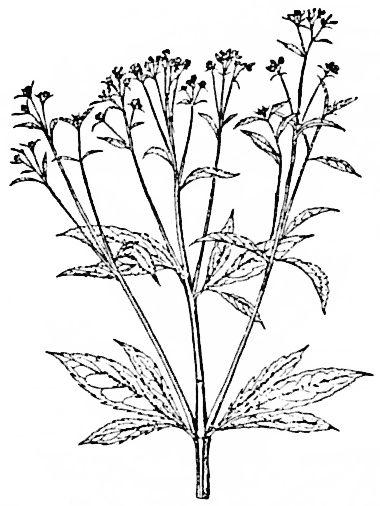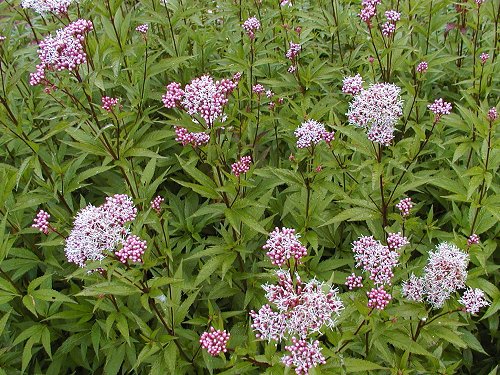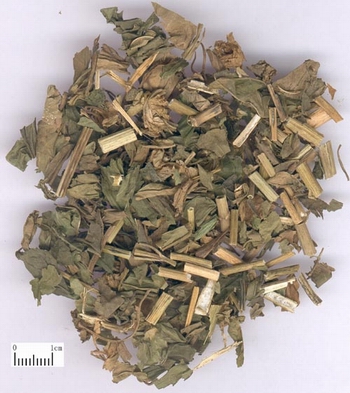- Dampness obstructing the middle Burner,
with
Agastache rugosa- Huo xiang and
Amomum
kravanh- Bai dou kou.
[5]
- Indigestion due to either Heat disorders or overindulging in fat, greasy foods.
Manifestating as regurgitation of a thick, turbid fluid, an umpleasant sticky
sensation in the mouth, bleching, and a white, greasy tongue coating. Use with
Coptis chinensis- Huang lian.
[5]
- Damp Summerheat, with
Agastache rugosa-
Huo xiang and
Artemisia annua- Qing hao.
[5]
- Early stages of Damp febrile diseases with
Talcum.htm-
Hua shi and
Coix lachryma- Yi yi ren.
[5]
Perennial herb 100 cm in height. Rhizome horizontal, stem erect. Leaves;
opposite, usually 3-deeply cleft, clefts long-rounded-lanceolate, with short petioles,
apexes gradually pointed, margins serrated, sparsely pubescent along ribs, emitting
a fragrance when shaken. Flowers; in autumn, purplish-red flowers appearing to
form capitulum inflorescences arranged to resemble cymose inflorescences. Achene;
cylindrical, blackish-brown when ripe.
[1] Barefoot Doctor's Manual- 1977 Prepared by the Revolutionary Health Committee
of Hunan Province. Original Chinese manual- Victor W. Sidel. Originally published
by Dr Joseph Quin and the Fogarty International centre, Bethdesda (1974). Madrona
Publishers Seattle Washington ISBN 0-914842-52-8.
[2] A Complete English Dictionary of Medicinal Terms in Chinese Acupuncture and
Herbalism 1981- Henry Lu Chinese Foundations of Natural Health- The Academy of
Oriental Heritage, Vancouver, Canada.
[3] Translation notes from Gary Seiford and Hocu Huhn- NSW College of Natural
Therapies. Sydney Australia (1982).
[4] Potter's New Cyclopaedia of Botanical Drugs and Preparations R.C.
Wren Revised by Elizabeth M. Williamson and Fred J Evans. First published in
Great Britain in 1988 and reprinted in 1989 and 1994 by the C. W. Daniel Company
Limited. 1 Church Path, Saffron Walden Essex. Published 1988 Printed and bound
by Biddles, Guildford ISBN 085207 1973.
[5] Chinese Herbal Medicine Materia Medica- Dan Bensky and Andrew Gamble- Eastland
Press 1986 Seattle Washington ISBN 0-939616-15-7
Images
1.
mitomori.co.jp
2.
[1]
2.
a-hospital.com
 Eupatorium fortunei. 佩 兰 Pèi lán Thoroughwort,
Ornamental orchid Family: Asteraceae
Eupatorium fortunei. 佩 兰 Pèi lán Thoroughwort,
Ornamental orchid Family: Asteraceae

 Research
Research